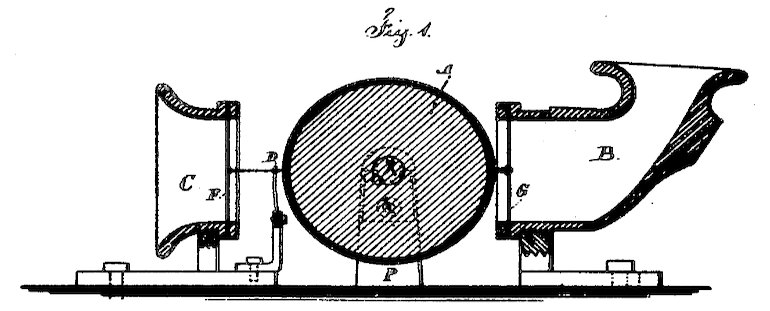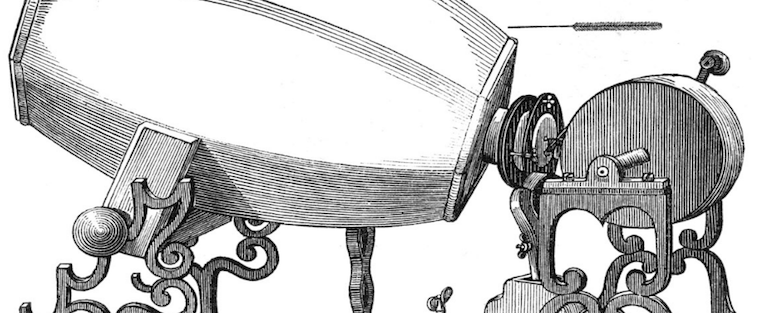Paul Hammant's Blog:
Blockchains for patent filings
TL;DR: Patents applications should be in blockchains - suggestion.
Obligatory ‘Thomas Edison patent-thief’ preamble

On the 24th December in 1877, Edison filed a patent with the US Patent and Trademarks office (USPTO) for the “Phonograph”. A couple of months later (19th February 1878), it was approved and published to the world. The Phonograph was a device which recorded sounds onto a cylinder. It played them back too, and was a precursor technology to record players. USPTO filing 200521 is the result (thanks Google).

Scott’s Phonautograph
Another fellow had “prior art” though - Edouard-Leon Scott de Martinville filed a patent in France on or before the 25th March, 1857 (when it was issued). Edison’s patent didn’t reference Scotts (or anyone else’s). Some have called it theft by Edison. In my opinion, it may be been granted anyway as it was a novel extension to Scott’s patent (it played sounds back - Scott’s did not).
Refer FirstSound.org’s clips from the French Patent office, INSI.
More Edison urban myths.
I heard a rumor that Edison would read unprocessed patent applications at his local patent office, and hurry back to his own office with clear understanding of the ones he’d wish were in his name. He’d quickly type them up (typewriters were commercially successful from 1868), and go back to the patent office and insert his under/before the one he’d want to steal. Of course, I can’t find a reference to that on line. Or my Google fu isn’t finding it. Or it wasn’t Edison. Never mind.
Patent rejection (the way it was)
At least in 1991, when I filed a patent you could get your patent rejected for reasons including prior art, but still have a small period of time to re-file with modifications to make it novel again. I didn’t re-file as my prior art was from the 1980’s, as I thought my invention was wholly novel when I originally applied. The UK patent office, back then, didn’t turn up the oldest prior art from 1896 (US), but that’s more about the non-integration of the world’s patent system’s in the early 90’s.
Scurrilous Nation States stealing patents
Let’s pretend patent theft are a real risk. Or better still, let’s pretend that nation-states have vested interests to ensure “their guy” invents the future ubiquitous and insanely profitable thing before someone from another nation does. Normally that’s called research and investment, but you could do it by backdating the filing date of a copy-cat patent. The gap between the filing and approval date was two months for Edison’s Phonograph, but can be a matter of years more recently. Cheating could also be, helping the local guy/gal fix up defects in the patent without a trail. You’d ‘launder’ the stolen intellectual property by finding a lesser-known university and some willing research students (co-patenting with their professor probably).
It is the 2020s I am worried about, as the hacking of ‘secure’ computers is happening 10x faster than the improvements to computers ability to guard secrets. The secret could be just that the research may pay off. For sure, patents are an esoteric case for the vulnerabilities of secrets that are held somewhere on the Internet, but they are an interesting case involving theft of an asset that is not directly or simply exchangable for funds that doesn’t generate an audit trail.
Blockchains to the rescue
We might have to pretend that patent theft is a risk risk today (it isn’t specifically, but industrial espionage is), or that we simply pine for a non-repudiable public ledger for worldwide patent system.
What if nations moved their patent systems to blockchains? That would be a ledger of filings. The filing would be identifiable via a key - US2016nnnnnnnnnnn for example, but otherwise encrypted with a private key. The public key, at the time of filing would not be disclosed. When the pronouncement is made (approved/rejected), the public key would be disclosed. How? In another entry in the blockchain of course.
If the patent had suffered modifications, those would be additional filings in the ledger with the encryption via the same private key and referring to the same ID.
With this system, patent applications couldn’t be backdated or altered without that being evident too.
My patent’s failed application isn’t in the UK intellectual property office’s database as it was rejected. There’s no reason that failed patent applications should be secret at all. Blockchain registered filings should become publically visible at the time of pronouncement, whether approved or rejected.
I’m not sure whether there’d be a single blockchain for all patent filings and pronouncements, or whether each nation would maintain their own. If the latter, other nations and the WIPO would track them all, of course.
Industrial espionage
Maybe to guard against industrial espionage companies need to place their research in blockchains in public. Similarly guarded by, but the twist is that they don’t intend to release the planning/research materials, but only to use them in intellectual property claims. Before something is patented it’s only a matter of trade-secrets and copyright.
Not so fast
It has to be noted that the above amounts to a use of blockchains that isn’t doubly anonymous, perhaps suggesting that the PKI nature of the multi-step disclosure process is the worthwhile change, though non-repudiability would be much harder. You’d need a directory structure and some form of Merkle tree setup for showing changes over time:
https://www.uspto.gov/pki-reboot/2016/11/02/US2016nnnnnnnnnnn/initialfiling.encrypted
https://www.uspto.gov/pki-reboot/2016/11/02/US2016nnnnnnnnnnn/status.encrypted
https://www.uspto.gov/pki-reboot/2016/11/02/US2016nnnnnnnnnnn/pubkey
https://www.uspto.gov/pki-reboot/2016/11/02/US2016nnnnnnnnnnn/sha1
https://www.uspto.gov/pki-reboot/2016/11/02/sha1
https://www.uspto.gov/pki-reboot/2016/11/sha1
https://www.uspto.gov/pki-reboot/2016/sha1
https://www.uspto.gov/pki-reboot/sha1
Of course, ‘centralized’ isn’t cool, while uses of distributed blockchains are :)
Footnotes
I’m not sure if anyone has talked of blockchains as the system of record for patent applications, but I couldn’t find refs if they had.